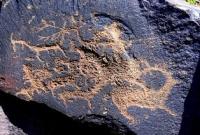Вы здесь
Karatau Petroglyphs.

Petroglyphs in the Karatau Mountains.
“Either Martian or lunar -
Alien landscape here.
Spur Tables Sail Out
Like an amazing mirage."
Raisa Yasonovna Grigorashvili. 04.22.1994.
Rock paintings in the Karatau mountains.
Petroglyphs in the Karatau mountains, date back to the 2nd millennium BC and the Middle Ages, rock paintings are in the Karatau mountains in southern Kazakhstan. Their presence in the Besaryk gorge was noted in 1906 by the topographer M.N. Kirchhoff.
In 1970 - 1971, in this gorge, the North-Karatau detachment of the South Kazakhstan archaeological expedition took copies of rock paintings and from the rock of Kuykeitai. Five groups of the petroglyph complex were studied in the Maydamtal tract (30 km from Besaryk).
Karatau petroglyphs - various images carved on the rocks of the Karatau gorges in the Bronze Age and the early Iron Age. Found in large numbers in the tracts of Koibagar, Arpaozen, Maydamtal, Ulkentura, Kysan, Zhyngylshak, Koshkarata, Suyundiksai, in the reserve Aksu-Zhabagly and in others.
Generally, the tracts are located on the territory of the Suzak region of the Turkestan region. 3045 compositions and individual images were found, and in Arpaozen tract - 2765. Petroglyphs were studied in the tract Maidamtal, Ulkentura.
Karatau petroglyphs are mainly carved on rocks and boulders of various sizes. They reflect the economic life of the nomadic tribes of the corresponding era, as well as their religious beliefs, customs, traditions, rites. There are images of birds, animals, animals.
The subject matter of the images is diverse, carries a certain semantic load. For example, the image of a camel symbolizes wealth and strength. On many rocks, scenes of hunting a mountain goat with dogs and bird catching are carved.
There are images of warriors with spears and clubs in their hands. Of particular value are about 50 images of military chariots and freight carts found in the last decade of the twentieth century. Among the Karatau cave paintings, they are considered particularly valuable.
Similar images are also found in Zhetysu - in the places of Tanbala, Esquiolmes and others. They are made in the same manner, and harness animals - horses or camels - are rarely depicted. Numerous drawings in the Karatau Mountains depicting scenes from the life of ancient pastoral tribes represent a valuable historical source that gives an idea of their economic and spiritual life.
Arpaozen petroglyphs belong to the 2nd - 1st millennium BC. e. They are located in the Suzak region of the Turkestan region, on the slope of the Kelinshtectu ridge in the Karatau mountains. Investigated by archaeological expeditions of the Academy of Sciences of Kazakhstan (M. Kadyrbaev, 1970, Z. Samashev, 1980).
The total number of drawings is 3.5 thousand, subjects are devoted to hunting and military scenes. Images of military chariots indicate that various battles took place on this territory.
Authority:
The book "Petroglyphs of Kulzhabasy", authors Baipakov K.M., Maryashev A.N. Almaty, 2004.







